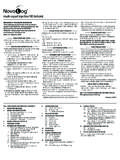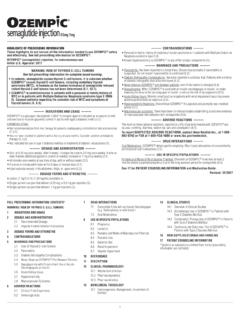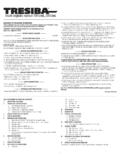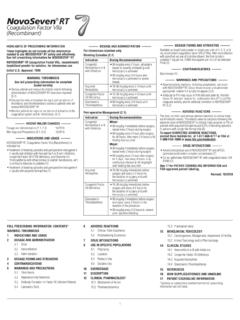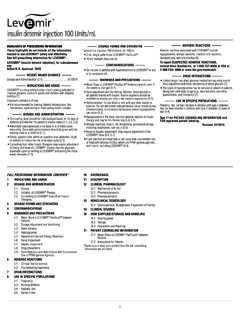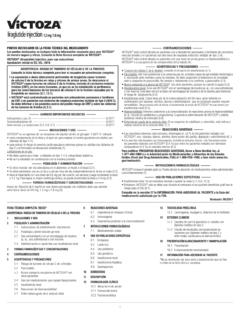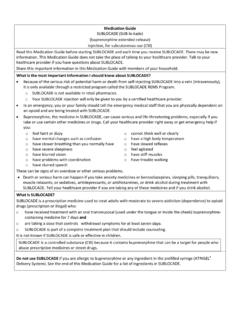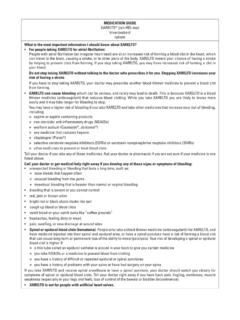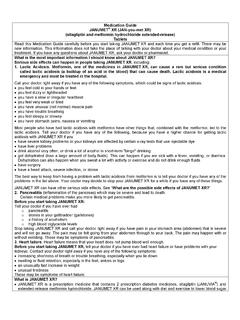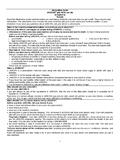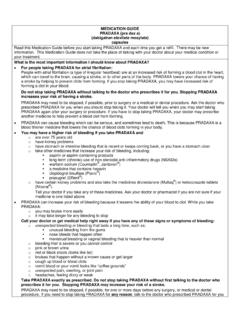Transcription of MEDICATION GUIDE What is the most important …
1 MEDICATION GUIDE Saxenda (sax-end-ah) (liraglutide) injection solution for subcutaneous use what is the most important information I should know about Saxenda? Serious side effects may happen in people who take Saxenda, including: Possible thyroid tumors, including cancer. Tell your healthcare provider if you get a lump or swelling in your neck, hoarseness, trouble swallowing, or shortness of breath. These may be symptoms of thyroid cancer. In studies with rats and mice, Saxenda and medicines that work like Saxenda caused thyroid tumors, including thyroid cancer. It is not known if Saxenda will cause thyroid tumors or a type of thyroid cancer called medullary thyroid carcinoma (MTC) in people. Do not use Saxenda if you or any of your family have ever had a type of thyroid cancer called medullary thyroid carcinoma (MTC), or if you have an endocrine system condition called Multiple Endocrine Neoplasia syndrome type 2 (MEN 2).
2 what is Saxenda? Saxenda is an injectable prescription medicine that may help some obese or overweight adults who also have weight related medical problems lose weight and keep the weight off. Saxenda should be used with a reduced calorie diet and increased physical activity. Saxenda is not for the treatment of type 2 diabetes mellitus. Saxenda and Victoza have the same active ingredient, liraglutide. Saxenda and Victoza should not be used together. Saxenda should not be used with other GLP-1 receptor agonist medicines. Saxenda and insulin should not be used together. It is not known if Saxenda is safe and effective when taken with other prescription, over-the-counter, or herbal weight loss products. It is not known if Saxenda changes your risk of heart problems or stroke or of death due to heart problems or stroke. It is not known if Saxenda can be used safely in people who have had pancreatitis.
3 It is not known if Saxenda is safe and effective in children under 18 years of age. Saxenda is not recommended for use in children. Who should not use Saxenda? Do not use Saxenda if: you or any of your family have a history of medullary thyroid carcinoma. you have Multiple Endocrine Neoplasia syndrome type 2 (MEN 2). This is a disease where people have tumors in more than one gland in their body. you are allergic to liraglutide or any of the ingredients in Saxenda. See the end of this MEDICATION GUIDE for a complete list of ingredients in Saxenda. Symptoms of a serious allergic reaction may include: swelling of your face, lips, tongue, or throat fainting or feeling dizzy very rapid heartbeat problems breathing or swallowing severe rash or itching Talk with your healthcare provider if you are not sure if you have any of these conditions.
4 Are pregnant or planning to become pregnant. Saxenda may harm your unborn baby. Before taking Saxenda, tell your healthcare provider about all of your medical conditions, including if you: have any of the conditions listed in the section what is the most important information I should know about Saxenda? are taking certain medications called GLP-1 receptor agonists. are allergic to liraglutide or any of the other ingredients in Saxenda. See the end of this MEDICATION GUIDE for a list of ingredients in Saxenda. have severe problems with your stomach, such as slowed emptying of your stomach (gastroparesis) or problems with digesting food. have or have had problems with your pancreas, kidneys or liver. have or have had depression or suicidal thoughts. are pregnant or plan to become pregnant. Saxenda may harm your unborn baby.
5 Tell your healthcare provider if you become pregnant while taking Saxenda. If you are pregnant you should stop using Saxenda. are breastfeeding or plan to breastfeed. It is not known if Saxenda passes into your breast milk. You and your healthcare provider should decide if you will take Saxenda or breastfeed. You should not do both without talking with your healthcare provider first. Tell your healthcare provider about all the medicines you take including prescription and over-the-counter medicines, vitamins, and herbal supplements. Saxenda slows stomach emptying and can affect medicines that need to pass through the stomach quickly. Saxenda may affect the way some medicines work and some other medicines may affect the way Saxenda works. Tell your healthcare provider if you take diabetes medicines, especially sulfonylurea medicines or insulin. How should I use Saxenda?
6 Use Saxenda exactly as prescribed by your healthcare provider. Your dose should be increased after using Saxenda for 1 week until you reach the 3 mg dose. After that, do not change your dose unless your healthcare provider tells you to. Saxenda is injected 1 time each day, at any time during the day. You can take Saxenda with or without food. Your healthcare provider should start you on a diet and exercise program when you start taking Saxenda. Stay on this program while you are taking Saxenda. Saxenda comes in a prefilled pen. Your healthcare provider must teach you how to inject Saxenda before you use it for the first time. If you have questions or do not understand the instructions, talk to your healthcare provider or pharmacist. Read the Patient Instructions for Use that come with this MEDICATION GUIDE for detailed information about the right way to use your Saxenda pen.
7 Pen needles are not included. Use the Saxenda pen with Novo Nordisk disposable needles. You may need a prescription to get pen needles from your pharmacist. Ask your healthcare provider which needle size is best for you. When starting a new prefilled Saxenda pen, you must follow the Check the Saxenda flow with each new pen (see the detailed Patient Instructions for Use that comes with this MEDICATION GUIDE ). You only need to do this 1 time with each new pen. You should also do this if you drop your pen. If you do the Check the Saxenda flow with each new pen before each injection, you will run out of medicine too soon. Inject your dose of Saxenda under the skin (subcutaneous injection) in your stomach area (abdomen), upper leg (thigh), or upper arm, as instructed by your healthcare provider. Do not inject into a vein or muscle. If you take too much Saxenda, call your healthcare provider right away.
8 Too much Saxenda may cause severe nausea and vomiting. If you miss your daily dose of Saxenda, use Saxenda as soon as you remember. Then take your next daily dose as usual on the following day. Do not take an extra dose of Saxenda or increase your dose on the following day to make up for your missed dose. If you miss your dose of Saxenda for 3 days or more, call your healthcare provider to talk about how to restart your treatment. Never share your Saxenda pen or needles with another person. You may give an infection to them, or get an infection from them. what are the possible side effects of Saxenda? Saxenda may cause serious side effects, including:possible thyroid tumors, including cancer. See what is the most important information I should know about Saxenda ? inflammation of the pancreas (pancreatitis). Stop using Saxenda and call your healthcare provider right away if you have severe pain in your stomach area (abdomen) that will not go away, with or without vomiting.
9 You may feel the pain from your abdomen to your back. gallbladder problems. Saxenda may cause gallbladder problems including gallstones. Some gallbladder problems need surgery. Call your healthcare provider if you have any of the following symptoms: pain in your upper stomach (abdomen) fever yellowing of your skin or eyes (jaundice) clay-colored stools low blood sugar (hypoglycemia) in people with type 2 diabetes mellitus who also take medicines to treat type 2 diabetes mellitus. Saxenda can cause low blood sugar in people with type 2 diabetes mellitus who also take medicines used to treat type 2 diabetes mellitus (such as sulfonylureas). In some people, the blood sugar may get so low that they need another person to help them. If you take a sulfonylurea medicine, the dose may need to be lowered while you use Saxenda. Signs and symptoms of low blood sugar may include: shakiness sweating headache drowsiness weakness dizziness confusion irritability hunger fast heartbeat feeling jittery Talk to your healthcare provider about how to recognize and treat low blood sugar.
10 Make sure that your family and other people who are around you a lot know how to recognize and treat low blood sugar. You should check your blood sugar before you start taking Saxenda and while you take Saxenda. increased heart rate. Saxenda can increase your heart rate while you are at rest. Your healthcare provider should check your heart rate while you take Saxenda. Tell your healthcare provider if you feel your heart racing or pounding in your chest and it lasts for several minutes when taking Saxenda. kidney problems (kidney failure). Saxenda may cause nausea, vomiting or diarrhea leading to loss of fluids (dehydration). Dehydration may cause kidney failure which can lead to the need for dialysis. This can happen in people who have never had kidney problems before. Drinking plenty of fluids may reduce your chance of dehydration. Call your healthcare provider right away if you have nausea, vomiting, or diarrhea that does not go away, or if you cannot drink liquids by mouth.
